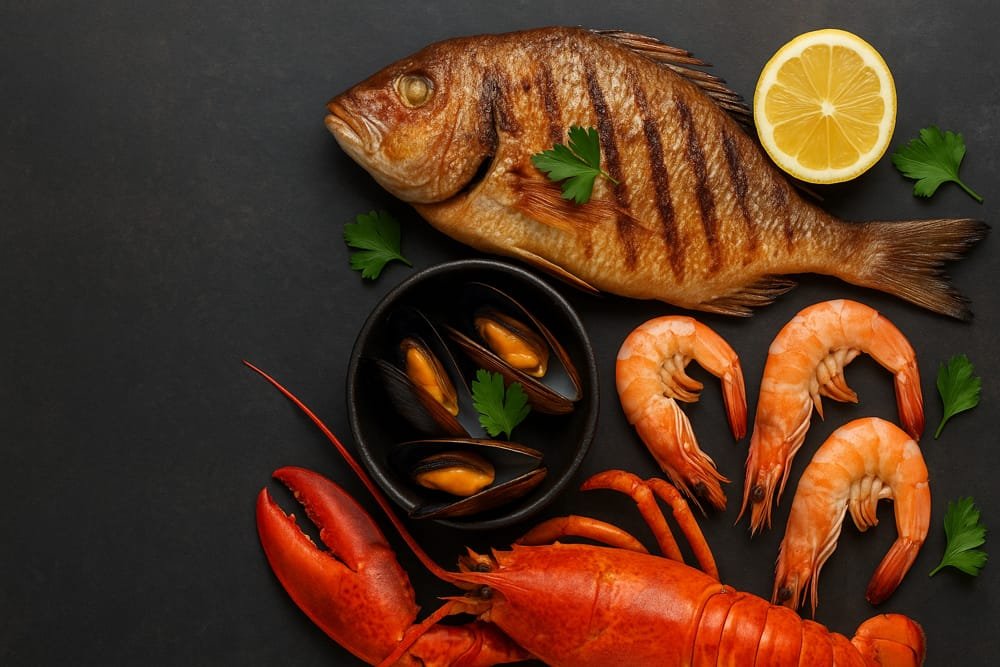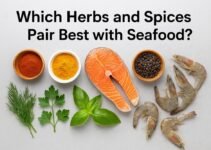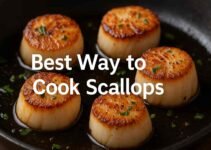Seafood is one of the most nutrient-dense food sources available, offering high-quality protein, essential omega-3 fatty acids, and key vitamins such as B12 and D. However, incorrect cooking methods can significantly reduce these health benefits and diminish the natural flavors that make seafood a culinary favorite. Studies show that up to 40% of water-soluble vitamins like B-complex can be lost through improper preparation. Similarly, excessive heat can degrade fragile omega-3 fatty acids, reducing their heart and brain health benefits.
This guide provides clear, actionable answers to the most common questions about cooking seafood for both maximum flavor and optimal nutrition. You will learn which cooking methods retain the highest nutrient levels, how to avoid common mistakes that destroy flavor, and which ingredients can naturally enhance taste without compromising health.
By the end of this guide, you will not only master healthier cooking techniques but also create seafood dishes that deliver rich flavors and unmatched nutritional value.
Contents
- 1 What Are the Health Benefits of Properly Cooked Seafood?
- 2 Which Cooking Methods Preserve the Most Nutrients in Seafood?
- 3 How Does Overcooking Affect the Flavor and Nutrition of Seafood?
- 4 What Are the Best Cooking Techniques for Popular Types of Seafood?
- 5 What Ingredients and Seasonings Enhance Seafood Flavor Without Compromising Nutrition?
- 6 How Does Marinating Seafood Affect Its Nutritional Profile?
- 7 Should You Cook Seafood with or Without the Skin to Maximize Benefits?
- 8 What Are the Common Mistakes That Ruin Seafood Nutrition and Flavor?
- 9 How Can Proper Cooking Techniques Support a Sustainable Seafood Diet?
What Are the Health Benefits of Properly Cooked Seafood?
Properly cooked seafood retains critical nutrients that directly support heart health, brain function, and immune system strength. The American Heart Association confirms that consuming two servings of properly prepared seafood weekly reduces the risk of heart disease by 36%. This is largely due to the preservation of omega-3 fatty acids, which lower triglyceride levels and stabilize heart rhythms.
Additionally, maintaining optimal cooking temperatures ensures the retention of vitamin D and selenium. Vitamin D supports calcium absorption, crucial for bone health, while selenium acts as a powerful antioxidant, protecting cells from oxidative stress.
For those concerned with immune support, correctly cooked seafood preserves zinc and iron, two minerals essential for white blood cell production and oxygen transport.
Which Nutrients in Seafood Are Most Sensitive to Cooking Methods?
The most sensitive nutrients in seafood are omega-3 fatty acids, B-complex vitamins, and vitamin D. High-heat methods like deep-frying can destroy over 50% of omega-3 content, while water-based methods like boiling leach out B vitamins, including B6 and B12.
To preserve these nutrients, favor cooking methods such as steaming, sous-vide, and gentle grilling. These techniques prevent nutrient degradation by maintaining lower, consistent temperatures and reducing direct contact with water.
How Does Proper Cooking Enhance Omega-3 Retention?
Omega-3 fatty acids degrade rapidly when exposed to high temperatures above 350°F (177°C). To retain these essential fats, seafood should be cooked at moderate temperatures and for limited durations.
For example, steaming salmon at around 212°F (100°C) preserves up to 90% of its omega-3 content, compared to just 45% retention when pan-fried at high heat.
Using cooking oils with high smoke points, such as avocado oil, also helps prevent oxidation of these healthy fats during preparation.
Which Cooking Methods Preserve the Most Nutrients in Seafood?
Steaming, sous-vide, and gentle grilling are the top three cooking methods for preserving seafood nutrients. These techniques maintain optimal temperatures and minimize nutrient loss caused by heat and water exposure.
High-heat methods like deep-frying and broiling at temperatures exceeding 400°F (204°C) destroy delicate omega-3 fatty acids and reduce water-soluble vitamins by over 40%. Additionally, cooking methods involving prolonged exposure to water, such as boiling, lead to significant leaching of minerals like zinc and iodine.
To maximize both flavor and nutrition, select methods that apply gentle heat and limit cooking time.
Is Steaming Seafood the Best Way to Preserve Nutrients?
Yes, steaming is one of the most effective methods for preserving the nutritional integrity of seafood. Steaming uses moist heat at approximately 212°F (100°C), which is low enough to prevent nutrient breakdown while cooking the seafood evenly.
Research from the Journal of Food Science shows that steaming retains up to 90% of vitamin B12 and 95% of omega-3 fatty acids in fish like salmon and mackerel. This method also keeps seafood moist and tender, enhancing natural flavors without requiring added fats or oils.
For best results, steam seafood for no longer than 6–10 minutes, depending on the type and thickness of the fillet.
How Does Sous-Vide Cooking Impact Seafood Nutrition and Flavor?
Sous-vide cooking preserves the highest percentage of nutrients while delivering exceptional flavor and texture. This method involves vacuum-sealing seafood and cooking it in a water bath at precisely controlled temperatures, typically between 120°F and 140°F (49°C to 60°C).
A study by the International Journal of Gastronomy and Food Science found that sous-vide retains up to 98% of omega-3 fatty acids and nearly 100% of vitamin D. Because the seafood cooks in its natural juices without direct exposure to high heat or oxygen, the risk of nutrient oxidation is minimized.
Sous-vide also enhances the flavor by maintaining moisture, resulting in soft, buttery textures without overcooking.
Can Grilling Seafood Retain Its Nutritional Value?
Grilling can retain nutritional value if done at moderate temperatures and for short cooking durations. To minimize nutrient loss, keep the grill temperature below 350°F (177°C) and avoid direct contact with open flames, which can create harmful compounds like heterocyclic amines (HCAs).
Using a foil wrap or grilling basket reduces charring and prevents excessive moisture loss. When done correctly, grilling preserves up to 80% of omega-3 content and maintains the integrity of heat-sensitive vitamins such as B6 and B12.
Marinating seafood before grilling with antioxidant-rich ingredients like lemon juice and olive oil further protects against nutrient degradation and enhances flavor naturally.
How Does Overcooking Affect the Flavor and Nutrition of Seafood?
Overcooking seafood leads to significant nutrient degradation and unpleasant changes in texture and flavor. Exposing seafood to temperatures above 350°F (177°C) for extended periods destroys delicate omega-3 fatty acids and reduces key vitamins such as B12 and D by up to 60%.
From a flavor perspective, overcooked seafood becomes dry, rubbery, and loses its natural sweetness. Essential amino acids undergo Maillard reactions at high temperatures, resulting in a bitter aftertaste rather than the desired umami flavor.
What Is the Ideal Internal Temperature for Different Types of Seafood?
Each type of seafood has a precise internal temperature that maximizes flavor and retains nutrients:
- Salmon and Tuna: 125°F (52°C) for a moist, flaky texture and maximum omega-3 retention.
- Shrimp and Scallops: 120°F (49°C) to preserve tenderness and avoid rubbery texture.
- White Fish (Cod, Halibut): 130°F (54°C) for firm yet moist results.
Using a digital food thermometer ensures accurate temperature control, reducing the risk of overcooking and nutrient loss.
How Do Texture and Moisture Loss Signal Nutrient Degradation?
Dry, rubbery seafood is a clear indicator of excessive moisture loss and nutrient breakdown. When seafood loses its internal moisture, water-soluble vitamins like B-complex and minerals such as potassium and zinc are depleted.
The muscle fibers contract excessively under high heat, expelling natural juices that carry these nutrients. This process not only affects nutritional value but also creates an unpleasant, dense texture.
To avoid this, apply moderate heat and remove seafood from the heat source when it reaches 5°F (2°C) below the target temperature, allowing residual heat to finish the cooking process.
What Are the Best Cooking Techniques for Popular Types of Seafood?
Each type of seafood responds differently to heat and cooking methods. Selecting the appropriate technique ensures optimal flavor, texture, and nutrient preservation.
How Should You Cook Salmon for Maximum Flavor and Nutrition?
The best way to cook salmon for both flavor and nutrition is by steaming or baking at low temperatures. Steaming at 212°F (100°C) preserves up to 90% of omega-3 fatty acids.
If baking, set the oven to 275°F (135°C) and cook for 15–20 minutes, depending on thickness. This low-temperature approach prevents the breakdown of essential fats and vitamins while delivering a tender, flaky texture.
What Is the Healthiest Way to Cook Shrimp Without Losing Taste?
Steaming and quick sautéing are the healthiest methods to cook shrimp without sacrificing flavor. Steam shrimp for just 3–5 minutes until they turn pink and opaque.
Alternatively, sauté in olive oil over medium heat for 2–3 minutes per side. Avoid overcooking, as shrimp quickly become tough and lose their natural sweetness when exposed to heat for too long.
How Can You Cook Scallops Perfectly to Retain Their Nutrients?
Searing scallops quickly at high heat preserves their nutrients and delivers a caramelized, flavorful crust. Heat a non-stick or cast-iron pan to 400°F (204°C) and sear for 90 seconds per side.
Do not exceed this time to avoid nutrient loss and texture degradation. Serve immediately to retain moisture and maximize nutrient content.
Are There Healthier Alternatives to Deep-Frying Fish?
Yes, baking, air-frying, and pan-searing are healthier alternatives to deep-frying fish while preserving flavor and nutrition. These methods significantly reduce unhealthy fat absorption and prevent the formation of harmful compounds like trans fats and acrylamides.
- Baking: Cook at 350°F (177°C) for 15–20 minutes. This method uses minimal oil and preserves omega-3 fatty acids.
- Air-Frying: Uses hot air circulation to achieve a crispy texture with up to 85% less oil compared to deep-frying.
- Pan-Searing: Requires just 1–2 tablespoons of healthy oils like olive or avocado oil, searing fish over medium heat for 2–3 minutes per side to lock in moisture and nutrients.
These alternatives offer the same satisfying texture as deep-frying without compromising cardiovascular health or increasing caloric intake.
What Ingredients and Seasonings Enhance Seafood Flavor Without Compromising Nutrition?
Using natural ingredients like fresh herbs, citrus fruits, and healthy oils enhances seafood flavor while preserving its nutritional profile. These additions contribute antioxidants and improve taste without the need for excess salt or unhealthy fats.
Which Healthy Fats Improve Seafood Flavor While Supporting Nutrition?
Olive oil, avocado oil, and flaxseed oil are the healthiest fats for enhancing seafood flavor. These oils contain high levels of monounsaturated and polyunsaturated fats, supporting heart health while amplifying natural seafood flavors.
For cooking, choose avocado oil due to its high smoke point (520°F / 271°C), which prevents oxidation. Use olive oil primarily for drizzling after cooking to preserve its nutritional properties.
How Do Fresh Herbs and Citrus Enhance Seafood Dishes Naturally?
Fresh herbs and citrus fruits enhance seafood flavor by adding brightness and complexity without relying on unhealthy additives. Herbs like parsley, dill, basil, and cilantro introduce aromatic oils and subtle bitterness that balance the natural sweetness of seafood.
Citrus fruits such as lemon, lime, and orange contribute both acidity and freshness. Their vitamin C content also supports collagen synthesis and aids in the absorption of iron from seafood. Adding a squeeze of lemon or a sprinkle of fresh herbs at the end of cooking preserves these flavors and nutrients, creating a vibrant and refreshing final dish.
Can You Use Low-Sodium Alternatives Without Sacrificing Taste?
Yes, using natural umami-rich ingredients and aromatic seasonings can reduce sodium without compromising flavor. Consider these alternatives:
- Seaweed flakes (nori, wakame): High in minerals and natural umami.
- Garlic and onion powder: Intensify flavor without added salt.
- Smoked paprika and black pepper: Add depth and complexity.
- Citrus zest and vinegar: Enhance brightness and reduce the need for salt.
A study by the American Journal of Clinical Nutrition found that substituting herbs and spices for salt reduced sodium intake by 30% while maintaining meal satisfaction levels.
How Does Marinating Seafood Affect Its Nutritional Profile?
Marinating seafood enhances flavor without significantly affecting its nutritional value when done correctly. The key is to use nutrient-rich ingredients and limit marinating time to prevent nutrient leaching, especially for delicate proteins like fish and shellfish.
Acidic marinades containing lemon juice or vinegar can slightly denature proteins, making seafood more tender. Before marinating, it’s important to ensure seafood is thoroughly cleaned; refer to our detailed guide on How to Clean Seafood Properly.
However, prolonged exposure beyond 30 minutes for fish and 1 hour for shellfish may lead to a loss of water-soluble vitamins such as B12 and B6.
Are There Nutrient-Boosting Ingredients You Should Add to Marinades?
Yes, incorporating antioxidant-rich and vitamin-dense ingredients can enhance both the flavor and nutritional profile of seafood. Recommended additions include:
- Lemon or lime juice: High in vitamin C, supports collagen production.
- Garlic and ginger: Contain bioactive compounds that boost immunity.
- Olive oil: Provides healthy monounsaturated fats and helps retain fat-soluble vitamins.
- Turmeric and black pepper: Powerful anti-inflammatory agents when combined.
Using these ingredients not only improves taste but also contributes additional health benefits.
How Long Should You Marinate Seafood Without Losing Nutrients?
The optimal marinating time depends on the type of seafood:
- Fish fillets (salmon, cod): 15–30 minutes.
- Shellfish (shrimp, scallops): 15–45 minutes.
- Whole fish: Up to 1 hour.
Avoid marinating seafood overnight, as prolonged exposure to acidic ingredients breaks down proteins excessively, leading to mushy texture and nutrient loss.
Should You Cook Seafood with or Without the Skin to Maximize Benefits?
Cooking seafood with the skin on preserves moisture, enhances flavor, and helps retain up to 15% more omega-3 fatty acids compared to skinless preparation. The skin acts as a natural barrier, preventing nutrient-rich juices from escaping during cooking.
Additionally, fish skin is a source of collagen and essential micronutrients like selenium and iodine. When crisped properly through searing or grilling, it also adds a desirable texture and flavor profile to the dish.
However, it is important to ensure the skin comes from sustainably sourced and contaminant-free seafood to avoid heavy metal exposure, particularly for species like swordfish and king mackerel.
What Are the Common Mistakes That Ruin Seafood Nutrition and Flavor?
Five common mistakes lead to nutrient loss and diminished flavor in seafood dishes:
- Overcooking: Causes nutrient degradation and dry, rubbery texture.
- High-heat frying: Destroys omega-3 fats and creates harmful compounds.
- Using excessive salt: Masks natural flavors and contributes to health risks like hypertension.
- Incorrect storage before cooking: Leads to bacterial growth and nutrient degradation.
- Reheating seafood: Reduces remaining nutrients by up to 30% and results in poor texture.
Avoid these errors by using moderate heat, fresh ingredients, and proper cooking techniques.
Is It True That Reheating Seafood Causes Nutrient Loss?
Yes, reheating seafood leads to significant nutrient loss, particularly of heat-sensitive vitamins such as B12 and D. A study published in the Journal of Food Processing found that reheating cooked seafood can decrease its vitamin content by 25–30% and further degrade delicate omega-3 fatty acids.
For best results, consume seafood immediately after cooking or store it at below 40°F (4°C) and consume within 24 hours without reheating.
How Does Using the Wrong Cookware Affect Seafood Quality?
Using reactive cookware like aluminum or non-coated cast iron can negatively impact seafood’s flavor and nutritional quality. Acidic marinades or sauces can react with these metals, leaching unwanted substances into the food and diminishing the natural taste.
Opt for non-reactive materials such as stainless steel, ceramic, or enameled cast iron, which maintain food safety and preserve the integrity of vitamins and minerals during cooking.
How Can Proper Cooking Techniques Support a Sustainable Seafood Diet?
Proper cooking techniques not only preserve nutrition but also support sustainable consumption by minimizing waste and maximizing resource utilization. When seafood is cooked correctly, there is less likelihood of discarding overcooked or poorly prepared portions, directly contributing to reduced food waste.
Additionally, gentle methods like steaming, sous-vide, and low-temperature baking use less energy compared to deep-frying or prolonged high-heat cooking, aligning with eco-friendly kitchen practices.
By mastering these methods, you not only prepare healthier and tastier meals but also actively contribute to protecting marine ecosystems. Responsible cooking supports sustainable seafood consumption by ensuring that every part of the seafood you purchase is used efficiently, honoring both the nutritional value and the environmental cost of these resources.



